Regulation of Coronavirus mRNA Transcription
IMDS材料数据系统使用指南(10.0版本)

1.4 1.5 1.6 127 日 2013 年 4 月 23 日
2013 年 5 月 24 日 2013 年 6 月 27 日
2013 年 12 月 12 日 2014 年 3 月 17 日 2014 年 7 月 13 日 2015 年 2 月 27 日 2015 年 4 月 27 日 2015 年 6 月 10 日 2015 年 6 月 11 日 2015 年 7 月 10 日
第3页
目录
1 IMDS – 简介.............................................................................................................................................................................................................. 7 2 IMDS – 使用入门 ...................................................................................................................................................................................................... 8
IMDS 服务中心 欧洲 | 电话: +36 1778-9821 | 电子邮件: imds-helpdesk-english@ 中国 | 电话: + 86 27 8743-1668 | 电子邮件: imds-eds-helpdesk-china@
【产品推荐】新冠病毒相关蛋白和抗体

【产品推荐】新冠病毒相关蛋白和抗体来源:菲恩生物发布时间:2022-01-20 13:48 点击量:133自从2019年爆发新冠疫情以来,病毒已经出现了很多变异株,那么为什么新冠病毒会不断出现新变异株?新冠病毒是一个RNA病毒,而RNA病毒在病毒复制过程中普遍具有较高的突变频率。
即使冠状病毒具有一定的纠错功能,病毒的突变频率也大约有百万分之三左右,换个说法就是,每次病毒复制产生的新病毒中,每10个病毒中就可能会有一个病毒出现突变。
因此,新突变株的出现对于新冠病毒来说是一个正常现象。
2021年11月9日,南非首次从病例样本中检测到一种新冠病毒B.1.1.529变异株。
短短2周时间,该变异株即成为南非豪登省新冠感染病例的绝对优势变异株,增长迅猛。
11月26日,WHO将其定义为第五种“关切变异株”(variant of concern, VOC),取名希腊字母Ο(奥密克戎)变异株。
世卫组织根据危险程度将新冠变异毒株分成了两类:令人担忧的变异毒株(VOC,variant of concern)和值得关注的变异毒株(VOI,variant of interest)。
前者在世界范围内引发的病例多、范围广,并有数据证实其传播能力、毒性强,或导致疫苗和临床治疗有效性降低;后者在世界范围内确认出现社区传播病例,或在多个国家被发现,但尚未形成大规模传染。
目前,VOC是对疫情影响最大同时也是对全球威胁最大的变异毒株,包括:Alpha、Beta、Gamma和Delta、omecoron五种。
上图为5种变异株的氨基酸突变位点比较南非疫情应对与创新中心主任奥利维拉表示,B.1.1.529存在“不同寻常的突变群”,共有50个突变,刺突蛋白上有32个突变。
美国全国公共广播电台称,Omicron的突变数量是德尔塔病毒的两倍之多。
COVID-19 Genomics UK Consortium(COG-UK)公司的SARS-CoV-2基因组团队发布了Omicron变体32个突变(左)的新图像。
小核酸药物的法规

小核酸药物的法规
小核酸药物是指分子量较小的核酸类药物,主要包括寡核苷酸、小干扰RNA(siRNA)、微小RNA(miRNA)等。
这类药物
在治疗遗传性疾病、感染性疾病、肿瘤等方面具有广泛的应用前景。
目前,针对小核酸药物的法规主要包括以下几个方面:
1. 临床试验要求:各国药品监管机构对小核酸药物的临床试验要求有一系列指导原则,包括试验设计、临床试验阶段、安全性评估等要求。
这些要求旨在保证药物的安全性和有效性。
2. 生产质量控制:各国药品监管部门要求小核酸药物的生产企业遵循一系列质量控制要求,包括药物的纯度、稳定性、批次一致性等方面的要求。
生产企业需要建立完善的质量管理体系,并通过各种检验手段确保药物的质量。
3. 审批要求:生产企业需要向相关药品监管部门提交申请,申请药品上市许可。
药品监管部门将对药物的安全性、有效性、质量控制等方面进行审查,审批通过后方可上市销售。
4. 监管体系:各国针对小核酸药物都建立了相应的监管体系,包括药品监管部门、药品注册制度、药品评价体系等。
这些监管体系旨在确保小核酸药物的生产、销售和使用具备规范性和安全性。
需要注意的是,不同国家对于小核酸药物的法规可能存在差异,
生产企业在开展跨国业务时需要充分了解各个国家的法规要求,并符合当地的要求进行药品研发、生产和销售。
mRNA疫苗研究进展及挑战
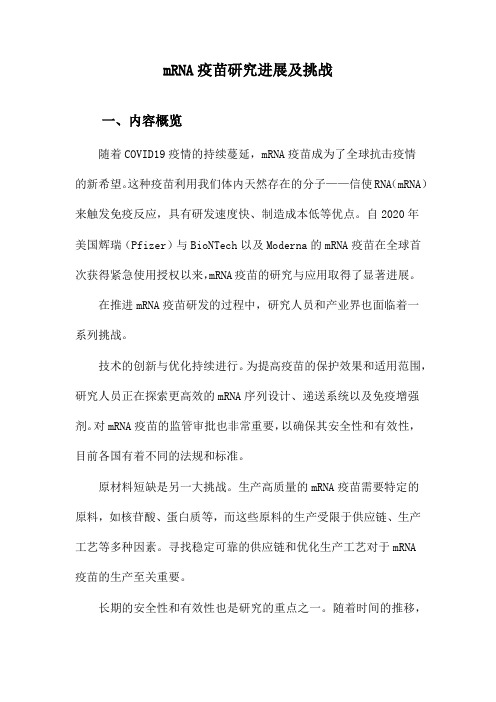
mRNA疫苗研究进展及挑战一、内容概览随着COVID19疫情的持续蔓延,mRNA疫苗成为了全球抗击疫情的新希望。
这种疫苗利用我们体内天然存在的分子——信使RNA(mRNA)来触发免疫反应,具有研发速度快、制造成本低等优点。
自2020年美国辉瑞(Pfizer)与BioNTech以及Moderna的mRNA疫苗在全球首次获得紧急使用授权以来,mRNA疫苗的研究与应用取得了显著进展。
在推进mRNA疫苗研发的过程中,研究人员和产业界也面临着一系列挑战。
技术的创新与优化持续进行。
为提高疫苗的保护效果和适用范围,研究人员正在探索更高效的mRNA序列设计、递送系统以及免疫增强剂。
对mRNA疫苗的监管审批也非常重要,以确保其安全性和有效性,目前各国有着不同的法规和标准。
原材料短缺是另一大挑战。
生产高质量的mRNA疫苗需要特定的原料,如核苷酸、蛋白质等,而这些原料的生产受限于供应链、生产工艺等多种因素。
寻找稳定可靠的供应链和优化生产工艺对于mRNA疫苗的生产至关重要。
长期的安全性和有效性也是研究的重点之一。
随着时间的推移,接种者可能会出现对mRNA疫苗的免疫耐受或抗体衰减等问题,从而影响疫苗效果的持久性。
研究人员需要进一步评估并改进疫苗的设计和制备工艺。
在全球范围内推广mRNA疫苗也面临诸多挑战。
一些国家或地区可能由于资金、技术或基础设施等方面的限制,而无法大规模生产或推广mRNA疫苗。
尽管mRNA疫苗在研发和应用方面已经取得了可观的进展,但仍需解决多项技术和实施层面的挑战。
未来的研究需要在确保疫苗质量和安全性的前提下,积极探索更有效的疫苗配方、递送系统和推广应用方式,以应对这场全球抗击疫情的战斗。
_______疫苗的简介mRNA疫苗是一种革命性的生物技术产品,它通过利用患者自身的细胞在体外合成病原体的一小部分(通常是刺突蛋白),从而激发免疫系统产生针对该病原体的免疫应答。
这种疫苗的优势在于制造速度较快、生产成本较低,并且对于开发和改进疫苗来说,研发过程相对简单。
新冠mrna疫苗作用原理的文献
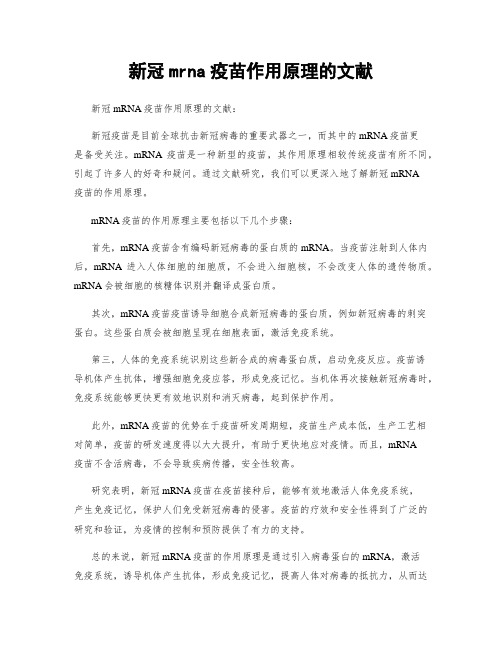
新冠mrna疫苗作用原理的文献新冠mRNA疫苗作用原理的文献:新冠疫苗是目前全球抗击新冠病毒的重要武器之一,而其中的mRNA疫苗更是备受关注。
mRNA疫苗是一种新型的疫苗,其作用原理相较传统疫苗有所不同,引起了许多人的好奇和疑问。
通过文献研究,我们可以更深入地了解新冠mRNA疫苗的作用原理。
mRNA疫苗的作用原理主要包括以下几个步骤:首先,mRNA疫苗含有编码新冠病毒的蛋白质的mRNA。
当疫苗注射到人体内后,mRNA进入人体细胞的细胞质,不会进入细胞核,不会改变人体的遗传物质。
mRNA会被细胞的核糖体识别并翻译成蛋白质。
其次,mRNA疫苗疫苗诱导细胞合成新冠病毒的蛋白质,例如新冠病毒的刺突蛋白。
这些蛋白质会被细胞呈现在细胞表面,激活免疫系统。
第三,人体的免疫系统识别这些新合成的病毒蛋白质,启动免疫反应。
疫苗诱导机体产生抗体,增强细胞免疫应答,形成免疫记忆。
当机体再次接触新冠病毒时,免疫系统能够更快更有效地识别和消灭病毒,起到保护作用。
此外,mRNA疫苗的优势在于疫苗研发周期短,疫苗生产成本低,生产工艺相对简单,疫苗的研发速度得以大大提升,有助于更快地应对疫情。
而且,mRNA疫苗不含活病毒,不会导致疾病传播,安全性较高。
研究表明,新冠mRNA疫苗在疫苗接种后,能够有效地激活人体免疫系统,产生免疫记忆,保护人们免受新冠病毒的侵害。
疫苗的疗效和安全性得到了广泛的研究和验证,为疫情的控制和预防提供了有力的支持。
总的来说,新冠mRNA疫苗的作用原理是通过引入病毒蛋白的mRNA,激活免疫系统,诱导机体产生抗体,形成免疫记忆,提高人体对病毒的抵抗力,从而达到预防疫病的效果。
疫苗的疗效和安全性得到了研究的支持,对疫情的控制和预防具有重要的意义。
mrna疫苗 标准 -回复
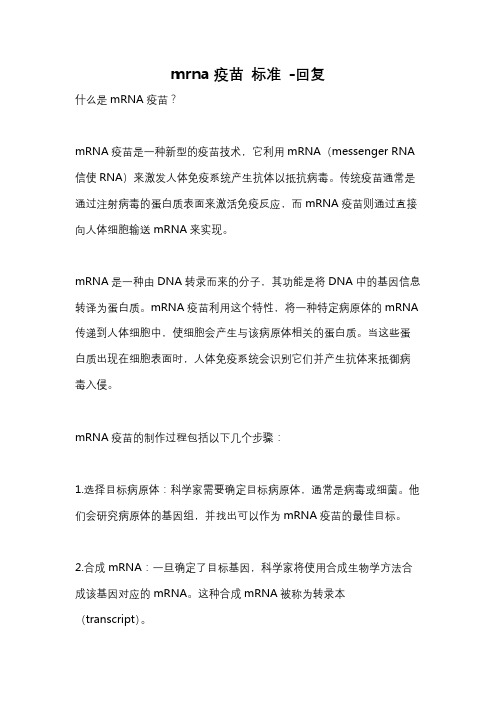
mrna疫苗标准-回复什么是mRNA疫苗?mRNA疫苗是一种新型的疫苗技术,它利用mRNA(messenger RNA 信使RNA)来激发人体免疫系统产生抗体以抵抗病毒。
传统疫苗通常是通过注射病毒的蛋白质表面来激活免疫反应,而mRNA疫苗则通过直接向人体细胞输送mRNA来实现。
mRNA是一种由DNA转录而来的分子,其功能是将DNA中的基因信息转译为蛋白质。
mRNA疫苗利用这个特性,将一种特定病原体的mRNA 传递到人体细胞中,使细胞会产生与该病原体相关的蛋白质。
当这些蛋白质出现在细胞表面时,人体免疫系统会识别它们并产生抗体来抵御病毒入侵。
mRNA疫苗的制作过程包括以下几个步骤:1.选择目标病原体:科学家需要确定目标病原体,通常是病毒或细菌。
他们会研究病原体的基因组,并找出可以作为mRNA疫苗的最佳目标。
2.合成mRNA:一旦确定了目标基因,科学家将使用合成生物学方法合成该基因对应的mRNA。
这种合成mRNA被称为转录本(transcript)。
3.包装和保护mRNA:由于mRNA在体内容易被分解,科学家需要通过包装和修饰来保护mRNA。
他们会将合成的mRNA封装在脂质纳米粒子中,以增加其稳定性。
4.注射mRNA疫苗:在疫苗接种过程中,mRNA疫苗被注射到人体肌肉组织中。
这个过程类似于传统疫苗的接种。
mRNA会进入肌肉细胞,并被细胞核内的机制识别为mRNA,并启动蛋白质合成过程。
5.蛋白质合成和抗体产生:在注射mRNA疫苗的细胞中,mRNA被转录成相应的蛋白质。
这些蛋白质会出现在细胞表面,激活人体免疫系统产生抗体。
这些抗体可以防止目标病原体的感染。
6.保护免疫:一旦人体产生了抗体,它们将留存在体内,以备将来遇到相同病原体的再次感染。
这种免疫反应可以提供长期的保护。
mRNA疫苗的优势之一是制备速度较快。
相比传统疫苗的制备时间,mRNA疫苗的制备时间较短。
这使得科学家能够更快地响应突发疫情,并进行大规模接种。
新冠病毒的RNA复制机制及抗病毒药物研发进展

新冠病毒的RNA复制机制及抗病毒药物研发进展新冠病毒,也被称为SARS-CoV-2,是一种具有高传染性的病毒,引发了全球范围内的COVID-19疫情。
了解新冠病毒的RNA复制机制以及抗病毒药物的研发进展对于控制疫情和治疗患者至关重要。
新冠病毒是一种正链单股RNA病毒,其基因组长度约为30,000个核苷酸,包含了几个重要的开放阅读框(ORF),编码了多种蛋白质。
其中,蛋白酶切割酶(proteases)、聚合酶(polymerase)以及血清素受体结合蛋白(S protein)等是RNA复制过程中至关重要的因子。
新冠病毒的RNA复制过程可以分为两个主要阶段:转化和复制。
在转化阶段,病毒进入宿主细胞,并释放其基因组RNA。
该RNA然后被翻译成多种蛋白质,这些蛋白质会进一步协助病毒进入复制阶段。
在复制阶段,由病毒聚合酶酶(RdRp)介导的RNA复制过程发生。
病毒RNA的复制是通过RdRp酶将RNA模板复制成新的RNA链实现的。
此过程需要多个辅助蛋白质的参与,其中包括RNA引物依赖性RNA聚合酶(primase)和RNA终止酶(nsp14-Exonuclease)。
了解新冠病毒RNA复制机制的关键过程为抗病毒药物的研发提供了重要的依据。
当下,研究人员正在积极寻找针对病毒复制的抗病毒药物。
一些已有的抗病毒药物,如瑞德西韦和氯喹,已被用于治疗新冠病毒感染的患者。
瑞德西韦是一种广谱抗病毒药物,通过抑制病毒RNA聚合酶来阻断病毒的复制。
临床试验显示,瑞德西韦对新冠病毒感染具有一定的疗效,可以减轻症状并缩短住院时间。
然而,它的疗效仍存在争议,并且需要进一步的研究来确定其在治疗中的作用。
氯喹是一种已有的抗疟药物,也在新冠病毒疫情暴发后被重新关注。
氯喹被认为具有抗病毒作用,可以阻止病毒进入宿主细胞。
然而,氯喹的临床疗效也存在争议,并且一些研究显示其可能对心脏产生不良影响。
除了已有的药物外,研发新的抗病毒药物也是当前的重要研究方向之一。
新冠疫苗的存储与运输要求
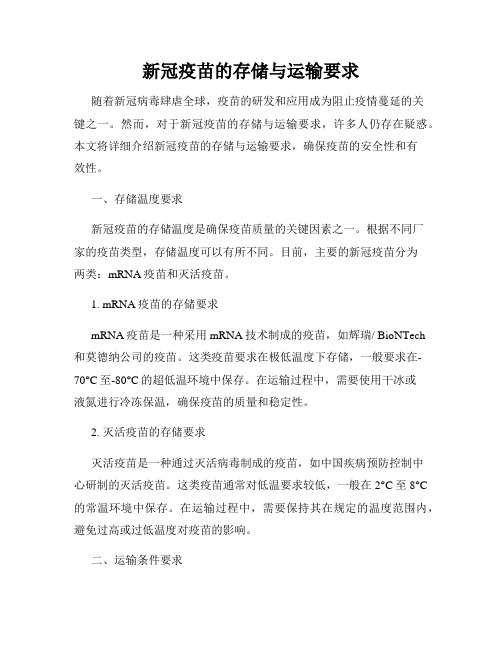
新冠疫苗的存储与运输要求随着新冠病毒肆虐全球,疫苗的研发和应用成为阻止疫情蔓延的关键之一。
然而,对于新冠疫苗的存储与运输要求,许多人仍存在疑惑。
本文将详细介绍新冠疫苗的存储与运输要求,确保疫苗的安全性和有效性。
一、存储温度要求新冠疫苗的存储温度是确保疫苗质量的关键因素之一。
根据不同厂家的疫苗类型,存储温度可以有所不同。
目前,主要的新冠疫苗分为两类:mRNA疫苗和灭活疫苗。
1. mRNA疫苗的存储要求mRNA疫苗是一种采用mRNA技术制成的疫苗,如辉瑞/ BioNTech和莫德纳公司的疫苗。
这类疫苗要求在极低温度下存储,一般要求在-70°C至-80°C的超低温环境中保存。
在运输过程中,需要使用干冰或液氮进行冷冻保温,确保疫苗的质量和稳定性。
2. 灭活疫苗的存储要求灭活疫苗是一种通过灭活病毒制成的疫苗,如中国疾病预防控制中心研制的灭活疫苗。
这类疫苗通常对低温要求较低,一般在2°C至8°C 的常温环境中保存。
在运输过程中,需要保持其在规定的温度范围内,避免过高或过低温度对疫苗的影响。
二、运输条件要求除了存储温度外,新冠疫苗的运输条件也是保证疫苗安全性和有效性的重要环节。
以下是新冠疫苗运输的一些要求:1. 冷链运输新冠疫苗通常采用冷链运输,确保疫苗在整个运输过程中始终处于规定的温度范围内。
冷链运输需要使用专门的冷库车辆或保温容器,避免温度波动对疫苗造成影响。
2. 运输记录和监控在运输过程中,需要对疫苗的运输情况进行记录和监控。
记录包括温度记录、时间记录等信息,用于追溯疫苗运输过程中的问题。
监控可以通过传感器等设备对疫苗进行实时监测,确保运输过程中的温度控制和疫苗的安全性。
3. 防护措施运输疫苗需要采取一系列的防护措施,避免疫苗在运输过程中受到污染或损坏。
这包括避免物理撞击、防水、防潮等措施,确保疫苗的完整性和稳定性。
三、疫苗接种点的存储要求除了运输环节外,疫苗接种点也需要满足一定的存储要求,确保疫苗在接种前的质量。
新冠mrna疫苗作用原理的文献
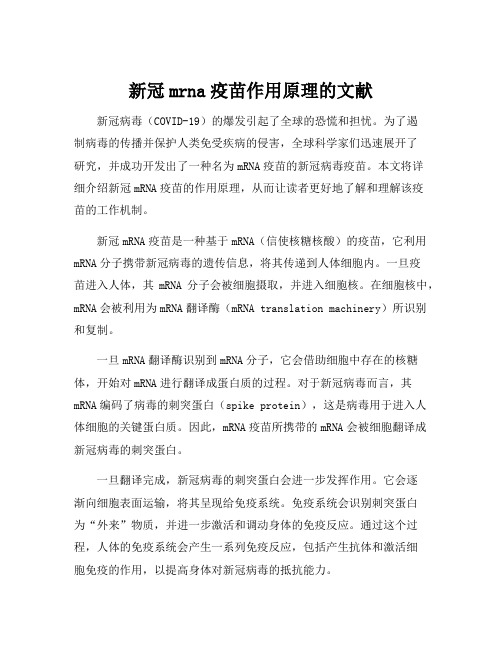
新冠mrna疫苗作用原理的文献新冠病毒(COVID-19)的爆发引起了全球的恐慌和担忧。
为了遏制病毒的传播并保护人类免受疾病的侵害,全球科学家们迅速展开了研究,并成功开发出了一种名为mRNA疫苗的新冠病毒疫苗。
本文将详细介绍新冠mRNA疫苗的作用原理,从而让读者更好地了解和理解该疫苗的工作机制。
新冠mRNA疫苗是一种基于mRNA(信使核糖核酸)的疫苗,它利用mRNA分子携带新冠病毒的遗传信息,将其传递到人体细胞内。
一旦疫苗进入人体,其mRNA分子会被细胞摄取,并进入细胞核。
在细胞核中,mRNA会被利用为mRNA翻译酶(mRNA translation machinery)所识别和复制。
一旦mRNA翻译酶识别到mRNA分子,它会借助细胞中存在的核糖体,开始对mRNA进行翻译成蛋白质的过程。
对于新冠病毒而言,其mRNA编码了病毒的刺突蛋白(spike protein),这是病毒用于进入人体细胞的关键蛋白质。
因此,mRNA疫苗所携带的mRNA会被细胞翻译成新冠病毒的刺突蛋白。
一旦翻译完成,新冠病毒的刺突蛋白会进一步发挥作用。
它会逐渐向细胞表面运输,将其呈现给免疫系统。
免疫系统会识别刺突蛋白为“外来”物质,并进一步激活和调动身体的免疫反应。
通过这个过程,人体的免疫系统会产生一系列免疫反应,包括产生抗体和激活细胞免疫的作用,以提高身体对新冠病毒的抵抗能力。
mRNA疫苗的作用原理具有多个优势。
首先,mRNA疫苗的生产速度较快,因为其制备过程借助了现代化的生物技术手段。
这意味着我们能够更迅速地应对病毒的变异和传播。
其次,mRNA疫苗的安全性较高,因为其不含有活病毒或与之相关的成分,减少了副作用的风险。
此外,mRNA疫苗还可以为不同病毒变种(如新冠病毒的变异株)进行快速定制和调整。
然而,我们也需要认识到mRNA疫苗的约束和限制。
首先,mRNA疫苗需要在低温条件下储存和运输,这对于一些发展中国家或一些偏远地区来说可能存在挑战。
新冠疫苗 mrna 说明书
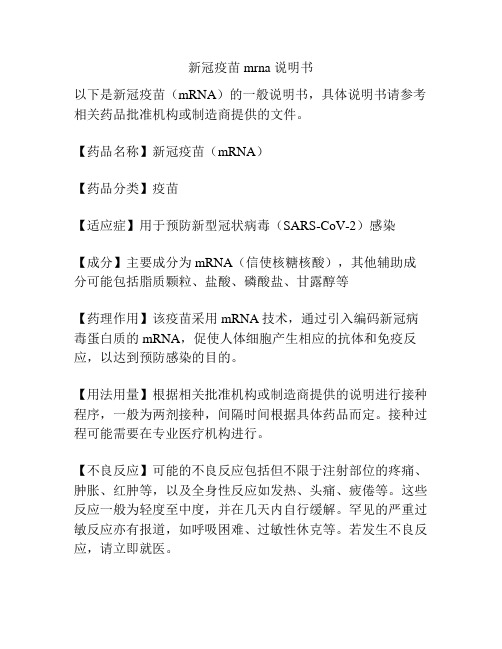
新冠疫苗 mrna 说明书
以下是新冠疫苗(mRNA)的一般说明书,具体说明书请参考相关药品批准机构或制造商提供的文件。
【药品名称】新冠疫苗(mRNA)
【药品分类】疫苗
【适应症】用于预防新型冠状病毒(SARS-CoV-2)感染
【成分】主要成分为mRNA(信使核糖核酸),其他辅助成分可能包括脂质颗粒、盐酸、磷酸盐、甘露醇等
【药理作用】该疫苗采用mRNA技术,通过引入编码新冠病毒蛋白质的mRNA,促使人体细胞产生相应的抗体和免疫反应,以达到预防感染的目的。
【用法用量】根据相关批准机构或制造商提供的说明进行接种程序,一般为两剂接种,间隔时间根据具体药品而定。
接种过程可能需要在专业医疗机构进行。
【不良反应】可能的不良反应包括但不限于注射部位的疼痛、肿胀、红肿等,以及全身性反应如发热、头痛、疲倦等。
这些反应一般为轻度至中度,并在几天内自行缓解。
罕见的严重过敏反应亦有报道,如呼吸困难、过敏性休克等。
若发生不良反应,请立即就医。
【禁忌症】适用人群一般包括大部分成年人,然而禁忌症可能包括对疫苗成分过敏的人群,以及某些特殊人群如孕妇、有严重免疫缺陷病史的人群等。
请咨询医生以判断适应症。
【药物相互作用】目前尚未掌握明确的药物相互作用,但请告知医师您正在使用的其他药物以避免不必要的风险。
【特别警示】请在专业医疗机构接种疫苗,遵循医生或专业人员的指导。
以上仅为一般说明书,不同疫苗品牌或不同地区批准的疫苗可能存在差异,请在接种前仔细阅读相关药品批准机构或制造商提供的详细说明书,并在接种前咨询医生以了解个人适应情况。
新型冠状病毒预防用mrna疫苗药学研究技术指导原则

新型冠状病毒预防用mrna疫苗药学研究技术
指导原则
新型冠状病毒预防用mrna疫苗药学研究是当前最高效的预防疾
病的方法之一,但也存在一定的风险。
因此,为了确保药物的安全性、有效性以及对社会效益的最大化,我们必须遵循科学家和医务人员都
认可的技术指导原则,以确保潜在受试者的安全。
首先,在进行新型冠状病毒预防用mrna疫苗药学研究时,必须
将安全性放在首位,确保受试者不受任何不良反应和未知风险的影响。
因此,研究必须严格按照GCP(良好临床实践)进行,准备和执行《临床试验协议》,同时确保受试者的隐私安全得到有效的保护。
其次,在研究疫苗药物有效性方面,除了考虑免疫力外,还必须
考虑到新型冠状病毒在不同年龄组和性别组中的传播情况,以及免疫
力对降低传播概率的影响程度。
因此,每一项研究必须采用充足的样本,彻底完成受试者的选择、检测和统计的数据分析,以确保研究结
果的可靠性和准确性。
最后,在新型冠状病毒预防用mrna疫苗药学研究中,为了确保
对社会的最大效益,必须考虑到成本问题,确保研发过程中的费用是
合理的。
为此,国家和有关部门应加强投资,加快药物研发进程,以
更低的成本生产药品,使其价格更实惠,更易于用户获得。
总而言之,新型冠状病毒预防用mrna疫苗药学研究必须遵循安
全性、有效性和对社会效益的最大化三条技术指导原则,以确保潜在
受试者的安全。
入出境航空器医学媒介生物控制标

题:入出境航空器医学媒介生物控制标近年来,随着国际旅游和贸易的不断发展,入出境航空器医学媒介生物控制标成为了全球关注的焦点。
作为一项重要的疾病预防措施,医学媒介生物控制标在国际航空旅行中扮演着重要的角色。
在本文中,我们将从深度和广度两个方面对该主题进行全面评估,并探讨其在全球范围内的重要性和应用前景。
1. 入出境航空器医学媒介生物控制标的概念入出境航空器医学媒介生物控制标,简称为医学媒介控制标(Medical Vector Control Mark),是指对航空器进行的一种特殊处理,以防止传播疾病。
主要针对航空器上可能存在的蚊虫、跳蚤、臭虫等媒介生物,通过特定的控制措施进行防治,以保障航空旅客和机组人员的健康安全。
2. 医学媒介生物控制标的重要性医学媒介生物控制标的实施对保障国际航空旅客的健康和安全具有重要意义。
航空器作为国际旅行的主要交通工具,其跨国跨境的特性使得媒介生物具有快速传播的潜在风险。
对航空器进行医学媒介生物控制可以有效减少疾病的传播风险,保障全球公共卫生安全。
医学媒介生物控制标的实施也有利于加强国际卫生检疫合作,促进国际间的卫生防控合作,推动全球公共卫生事业的发展。
3. 入出境航空器医学媒介生物控制标的实施范围和方法医学媒介生物控制标的实施范围包括航空器的内部和外部。
在航空器内部,主要通过定期清洁、喷洒杀虫剂等方式进行控制;在航空器外部,则通过对停靠地的环境进行监测、对航空器外壳进行清洁和处理等方式进行控制。
医学媒介生物控制标的实施方法包括物理除害、化学灭杀和生物防治等多种手段,以确保航空器的卫生安全。
4. 对入出境航空器医学媒介生物控制标的个人观点和理解个人认为入出境航空器医学媒介生物控制标的实施对于国际卫生防控具有重要意义。
在全球化背景下,各国之间的疾病传播风险不断增加,而航空器作为国际旅行的主要交通方式,具有传播疾病的潜在风险。
加强对航空器的医学媒介生物控制标实施,不仅有利于保障国际航空旅客的健康安全,而且有助于推动全球卫生事业的发展,促进各国之间的卫生防控合作。
4.5污水监测与防控参考答案
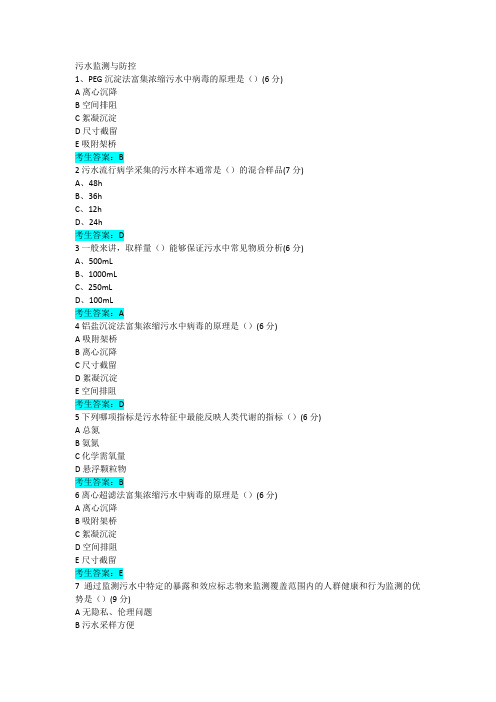
污水监测与防控1、PEG沉淀法富集浓缩污水中病毒的原理是()(6分)A离心沉降B空间排阻C絮凝沉淀D尺寸截留E吸附架桥考生答案:B2污水流行病学采集的污水样本通常是()的混合样品(7分)A、48hB、36hC、12hD、24h考生答案:D3一般来讲,取样量()能够保证污水中常见物质分析(6分)A、500mLB、1000mLC、250mLD、100mL考生答案:A4铝盐沉淀法富集浓缩污水中病毒的原理是()(6分)A吸附架桥B离心沉降C尺寸截留D絮凝沉淀E空间排阻考生答案:D5下列哪项指标是污水特征中最能反映人类代谢的指标()(6分)A总氮B氨氮C化学需氧量D悬浮颗粒物考生答案:B6离心超滤法富集浓缩污水中病毒的原理是()(6分)A离心沉降B吸附架桥C絮凝沉淀D空间排阻E尺寸截留考生答案:E7通过监测污水中特定的暴露和效应标志物来监测覆盖范围内的人群健康和行为监测的优势是()(9分)A无隐私、伦理问题B污水采样方便C能够提供客观、连续、实时的数据D监测范围大E成本低考生答案:A,B,C,D,E8污水流行病学涉及的学科包括()(9分)A社会行为学B分析化学C流行病学D环境科学考生答案:A,B,C,D9《污水中新型冠状病毒富集浓缩和核酸检测方法标准》(WS/T799-2022)中污水中病毒核酸富集浓缩方法有()(9分)A、裂解法B、铝盐沉淀C、PEGD、磁珠法E、超滤考生答案:B,C,E10美国环保署局ChristianG.Daughton博士首次提出污水流行病学概念。
()(6分)A正确B错误考生答案:A11污水流行病学的研究对象是市政污水。
()(6分)A正确B错误考生答案:A12适宜的生物标志物需要有较大的水溶解度,具有较大的颗粒物水分配系数,不易被污水中的悬浮颗粒物吸附。
()(6分)A正确B错误考生答案:B13我国新冠病毒多渠道监测预警体系包括抗原检测、发热门诊监测、污水监测、哨点医院监测、病毒变异监测、疫苗接种监测、住院诊疗情况监测。
新冠mrna疫苗作用原理的文献
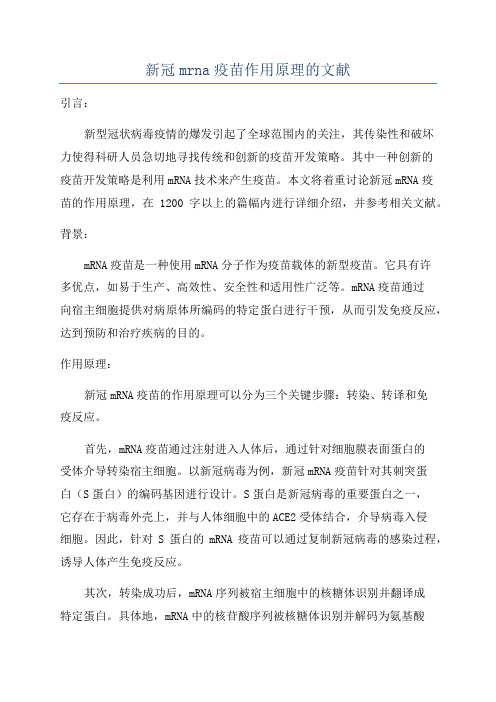
新冠mrna疫苗作用原理的文献引言:新型冠状病毒疫情的爆发引起了全球范围内的关注,其传染性和破坏力使得科研人员急切地寻找传统和创新的疫苗开发策略。
其中一种创新的疫苗开发策略是利用mRNA技术来产生疫苗。
本文将着重讨论新冠mRNA疫苗的作用原理,在1200字以上的篇幅内进行详细介绍,并参考相关文献。
背景:mRNA疫苗是一种使用mRNA分子作为疫苗载体的新型疫苗。
它具有许多优点,如易于生产、高效性、安全性和适用性广泛等。
mRNA疫苗通过向宿主细胞提供对病原体所编码的特定蛋白进行干预,从而引发免疫反应,达到预防和治疗疾病的目的。
作用原理:新冠mRNA疫苗的作用原理可以分为三个关键步骤:转染、转译和免疫反应。
首先,mRNA疫苗通过注射进入人体后,通过针对细胞膜表面蛋白的受体介导转染宿主细胞。
以新冠病毒为例,新冠mRNA疫苗针对其刺突蛋白(S蛋白)的编码基因进行设计。
S蛋白是新冠病毒的重要蛋白之一,它存在于病毒外壳上,并与人体细胞中的ACE2受体结合,介导病毒入侵细胞。
因此,针对S蛋白的mRNA疫苗可以通过复制新冠病毒的感染过程,诱导人体产生免疫反应。
其次,转染成功后,mRNA序列被宿主细胞中的核糖体识别并翻译成特定蛋白。
具体地,mRNA中的核苷酸序列被核糖体识别并解码为氨基酸序列,从而合成出特定的蛋白质。
在新冠mRNA疫苗中,翻译的是S蛋白。
此外,为提高免疫原性,mRNA序列还经过优化和修饰,使得合成的蛋白质更加稳定、富含必要的抗原表位,并能有效地激活免疫系统。
最后,合成的S蛋白会被细胞进行后续的加工和呈递,刺激人体产生免疫反应。
免疫反应主要分为细胞免疫和体液免疫两个方面。
细胞免疫是通过CD8+T淋巴细胞的活化和介导来实现的,它可以杀伤受感染的细胞。
体液免疫则是通过产生特异性抗体来中和病原体,从而阻止病毒进一步感染人体细胞。
新冠mRNA疫苗可以同时激活这两种免疫反应,并促使机体产生抗新冠病毒的免疫保护。
mrna质量控制指导原则中美对比
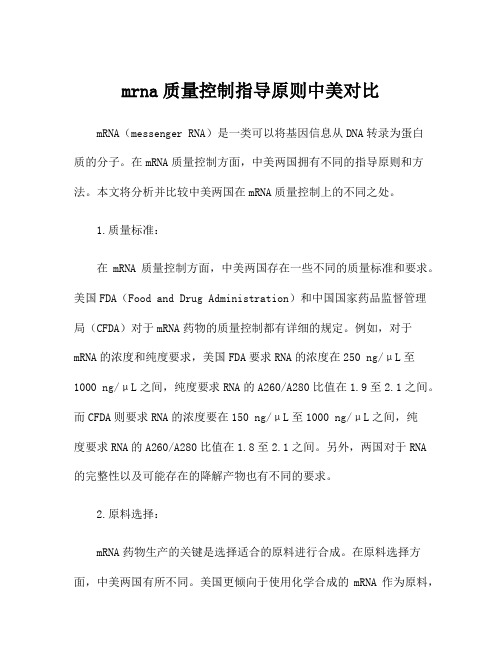
mrna质量控制指导原则中美对比mRNA(messenger RNA)是一类可以将基因信息从DNA转录为蛋白质的分子。
在mRNA质量控制方面,中美两国拥有不同的指导原则和方法。
本文将分析并比较中美两国在mRNA质量控制上的不同之处。
1.质量标准:在mRNA质量控制方面,中美两国存在一些不同的质量标准和要求。
美国FDA(Food and Drug Administration)和中国国家药品监督管理局(CFDA)对于mRNA药物的质量控制都有详细的规定。
例如,对于mRNA的浓度和纯度要求,美国FDA要求RNA的浓度在250 ng/μL至1000 ng/μL之间,纯度要求RNA的A260/A280比值在1.9至2.1之间。
而CFDA则要求RNA的浓度要在150 ng/μL至1000 ng/μL之间,纯度要求RNA的A260/A280比值在1.8至2.1之间。
另外,两国对于RNA 的完整性以及可能存在的降解产物也有不同的要求。
2.原料选择:mRNA药物生产的关键是选择适合的原料进行合成。
在原料选择方面,中美两国有所不同。
美国更倾向于使用化学合成的mRNA作为原料,通过化学方法合成mRNA的质量更容易控制。
而中国则更倾向于使用从真核细胞中提取的mRNA作为原料,这种原料的质量会受到真核细胞的影响,因此对于原料的筛选和处理更为关键。
3.合成方法:mRNA的合成方法也是质量控制的关键环节。
在合成方法上,中美两国也存在所不同的偏好。
美国更多地使用体外转录方法进行mRNA的合成,该方法可以在体外进行mRNA转录反应,更易于控制合成的参数和条件。
中国更多地使用原核细胞系统进行mRNA的合成,该方法可以在原核细胞中进行mRNA的转录和翻译,更适合大规模的mRNA合成。
4.质控方法:在mRNA质量控制方面,中美两国也有不同的质控方法。
美国更倾向于使用封闭式质控方法,即在整个合成过程中对关键步骤进行监控和控制。
例如,在酶反应的过程中,美国会使用合适的质控标准和方法对酶的活性和纯度进行检测和控制。
mrna疫苗用酶相关法规
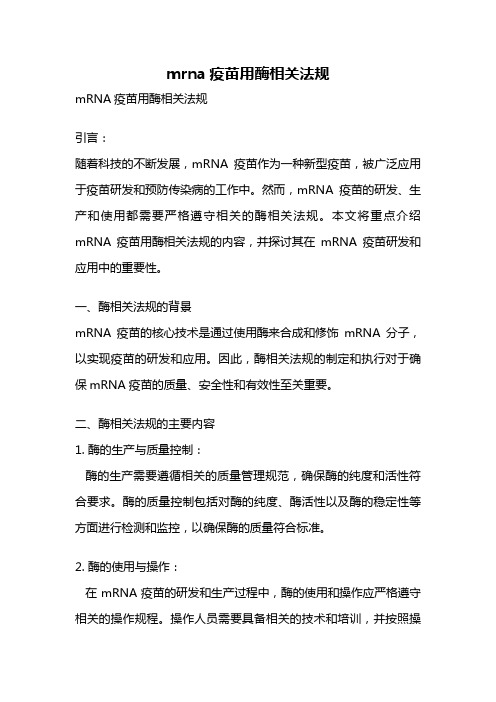
mrna疫苗用酶相关法规mRNA疫苗用酶相关法规引言:随着科技的不断发展,mRNA疫苗作为一种新型疫苗,被广泛应用于疫苗研发和预防传染病的工作中。
然而,mRNA疫苗的研发、生产和使用都需要严格遵守相关的酶相关法规。
本文将重点介绍mRNA疫苗用酶相关法规的内容,并探讨其在mRNA疫苗研发和应用中的重要性。
一、酶相关法规的背景mRNA疫苗的核心技术是通过使用酶来合成和修饰mRNA分子,以实现疫苗的研发和应用。
因此,酶相关法规的制定和执行对于确保mRNA疫苗的质量、安全性和有效性至关重要。
二、酶相关法规的主要内容1. 酶的生产与质量控制:酶的生产需要遵循相关的质量管理规范,确保酶的纯度和活性符合要求。
酶的质量控制包括对酶的纯度、酶活性以及酶的稳定性等方面进行检测和监控,以确保酶的质量符合标准。
2. 酶的使用与操作:在mRNA疫苗的研发和生产过程中,酶的使用和操作应严格遵守相关的操作规程。
操作人员需要具备相关的技术和培训,并按照操作规程进行操作,以确保酶的正确使用和安全性。
3. 酶的储存与运输:酶的储存和运输需要在适当的温度和湿度条件下进行,以确保酶的稳定性和活性不受损。
储存和运输过程中需要采取相应的措施,如冷冻、干燥等,以保护酶的活性。
4. 酶相关的安全措施:在酶的使用和操作过程中,需要采取相应的安全措施,以保护操作人员和环境的安全。
这包括佩戴个人防护装备、进行实验室安全培训、进行风险评估和控制等。
三、酶相关法规的重要性1. 保障mRNA疫苗的质量和安全性:酶相关法规的执行可以确保酶的质量和活性符合要求,从而保证mRNA疫苗的质量和安全性。
只有在酶的质量可靠的前提下,才能确保mRNA疫苗的效果和疗效。
2. 促进mRNA疫苗的研发和应用:酶相关法规的制定和执行为mRNA疫苗的研发和应用提供了规范和指导。
只有在遵守相关法规的前提下,才能推动mRNA疫苗的研发和应用,促进疫苗领域的发展。
3. 维护公众的信任和接受度:酶相关法规的执行可以提高mRNA疫苗的质量和安全性,增强公众对疫苗的信任和接受度。
mrna疫苗 标准
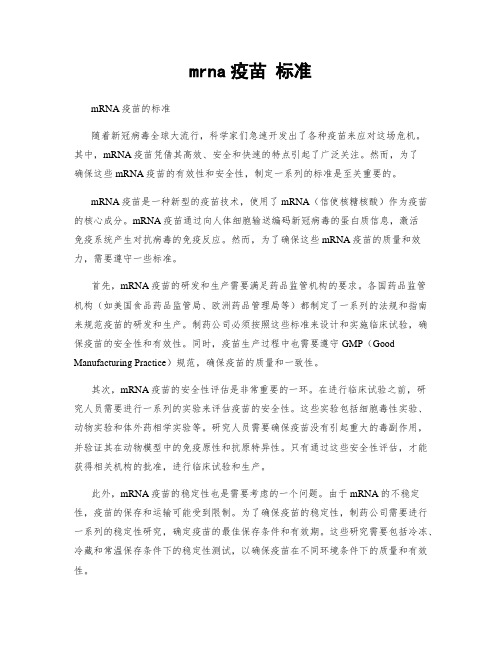
mrna疫苗标准mRNA疫苗的标准随着新冠病毒全球大流行,科学家们急速开发出了各种疫苗来应对这场危机。
其中,mRNA疫苗凭借其高效、安全和快速的特点引起了广泛关注。
然而,为了确保这些mRNA疫苗的有效性和安全性,制定一系列的标准是至关重要的。
mRNA疫苗是一种新型的疫苗技术,使用了mRNA(信使核糖核酸)作为疫苗的核心成分。
mRNA疫苗通过向人体细胞输送编码新冠病毒的蛋白质信息,激活免疫系统产生对抗病毒的免疫反应。
然而,为了确保这些mRNA疫苗的质量和效力,需要遵守一些标准。
首先,mRNA疫苗的研发和生产需要满足药品监管机构的要求。
各国药品监管机构(如美国食品药品监管局、欧洲药品管理局等)都制定了一系列的法规和指南来规范疫苗的研发和生产。
制药公司必须按照这些标准来设计和实施临床试验,确保疫苗的安全性和有效性。
同时,疫苗生产过程中也需要遵守GMP(Good Manufacturing Practice)规范,确保疫苗的质量和一致性。
其次,mRNA疫苗的安全性评估是非常重要的一环。
在进行临床试验之前,研究人员需要进行一系列的实验来评估疫苗的安全性。
这些实验包括细胞毒性实验、动物实验和体外药相学实验等。
研究人员需要确保疫苗没有引起重大的毒副作用,并验证其在动物模型中的免疫原性和抗原特异性。
只有通过这些安全性评估,才能获得相关机构的批准,进行临床试验和生产。
此外,mRNA疫苗的稳定性也是需要考虑的一个问题。
由于mRNA的不稳定性,疫苗的保存和运输可能受到限制。
为了确保疫苗的稳定性,制药公司需要进行一系列的稳定性研究,确定疫苗的最佳保存条件和有效期。
这些研究需要包括冷冻、冷藏和常温保存条件下的稳定性测试,以确保疫苗在不同环境条件下的质量和有效性。
最后,mRNA疫苗的效力评估是判断其是否符合标准的重要指标之一。
临床试验是评估疫苗效力的关键步骤。
在进行临床试验时,研究人员需要招募足够数量的受试者,并对疫苗和对照组进行随机分组。
mRNA疫苗产生的有毒S蛋白
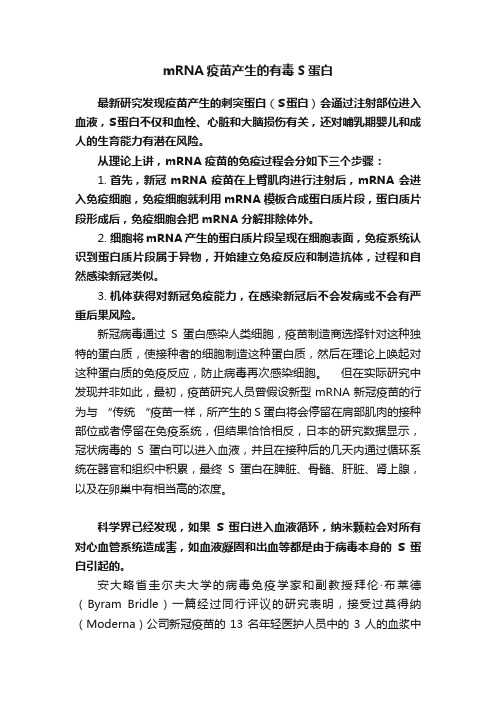
mRNA疫苗产生的有毒S蛋白最新研究发现疫苗产生的刺突蛋白(S蛋白)会通过注射部位进入血液,S蛋白不仅和血栓、心脏和大脑损伤有关,还对哺乳期婴儿和成人的生育能力有潜在风险。
从理论上讲,mRNA疫苗的免疫过程会分如下三个步骤:1.首先,新冠mRNA疫苗在上臂肌肉进行注射后,mRNA会进入免疫细胞,免疫细胞就利用mRNA模板合成蛋白质片段,蛋白质片段形成后,免疫细胞会把mRNA分解排除体外。
2.细胞将mRNA产生的蛋白质片段呈现在细胞表面,免疫系统认识到蛋白质片段属于异物,开始建立免疫反应和制造抗体,过程和自然感染新冠类似。
3.机体获得对新冠免疫能力,在感染新冠后不会发病或不会有严重后果风险。
新冠病毒通过S蛋白感染人类细胞,疫苗制造商选择针对这种独特的蛋白质,使接种者的细胞制造这种蛋白质,然后在理论上唤起对这种蛋白质的免疫反应,防止病毒再次感染细胞。
但在实际研究中发现并非如此,最初,疫苗研究人员曾假设新型mRNA新冠疫苗的行为与“传统“疫苗一样,所产生的S蛋白将会停留在肩部肌肉的接种部位或者停留在免疫系统,但结果恰恰相反,日本的研究数据显示,冠状病毒的S蛋白可以进入血液,并且在接种后的几天内通过循环系统在器官和组织中积累,最终S蛋白在脾脏、骨髓、肝脏、肾上腺,以及在卵巢中有相当高的浓度。
科学界已经发现,如果S蛋白进入血液循环,纳米颗粒会对所有对心血管系统造成害,如血液凝固和出血等都是由于病毒本身的S蛋白引起的。
安大略省圭尔夫大学的病毒免疫学家和副教授拜伦·布莱德(Byram Bridle)一篇经过同行评议的研究表明,接受过莫得纳(Moderna)公司新冠疫苗的13名年轻医护人员中的3人的血浆中检测到了S蛋白。
在其中一名工人身上,S蛋白在体内循环了29天。
实验动物在血液中注射了纯化的S蛋白后出现了心血管问题,而且S蛋白还被证明可以穿过血脑屏障并对大脑造成损害。
以前疫苗研究者错误是认为S蛋白是一种很好的目标抗原,不是一种毒素或致病蛋白,而且不会进入血液循环中。
新型冠状病毒中的名词解释
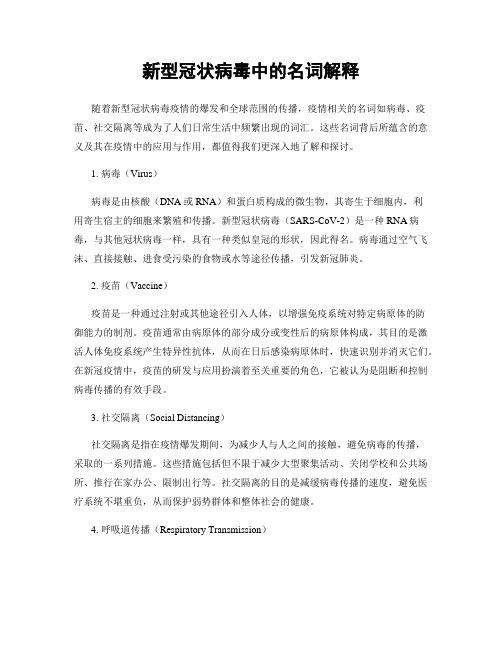
新型冠状病毒中的名词解释随着新型冠状病毒疫情的爆发和全球范围的传播,疫情相关的名词如病毒、疫苗、社交隔离等成为了人们日常生活中频繁出现的词汇。
这些名词背后所蕴含的意义及其在疫情中的应用与作用,都值得我们更深入地了解和探讨。
1. 病毒(Virus)病毒是由核酸(DNA或RNA)和蛋白质构成的微生物,其寄生于细胞内,利用寄生宿主的细胞来繁殖和传播。
新型冠状病毒(SARS-CoV-2)是一种RNA病毒,与其他冠状病毒一样,具有一种类似皇冠的形状,因此得名。
病毒通过空气飞沫、直接接触、进食受污染的食物或水等途径传播,引发新冠肺炎。
2. 疫苗(Vaccine)疫苗是一种通过注射或其他途径引入人体,以增强免疫系统对特定病原体的防御能力的制剂。
疫苗通常由病原体的部分成分或变性后的病原体构成,其目的是激活人体免疫系统产生特异性抗体,从而在日后感染病原体时,快速识别并消灭它们。
在新冠疫情中,疫苗的研发与应用扮演着至关重要的角色,它被认为是阻断和控制病毒传播的有效手段。
3. 社交隔离(Social Distancing)社交隔离是指在疫情爆发期间,为减少人与人之间的接触,避免病毒的传播,采取的一系列措施。
这些措施包括但不限于减少大型聚集活动、关闭学校和公共场所、推行在家办公、限制出行等。
社交隔离的目的是减缓病毒传播的速度,避免医疗系统不堪重负,从而保护弱势群体和整体社会的健康。
4. 呼吸道传播(Respiratory Transmission)呼吸道传播是指病毒主要通过呼吸道途径(如空气飞沫、咳嗽或打喷嚏)传播给其他人。
新冠病毒具有较强的呼吸道传播性,使其在社区中快速传播。
因此,佩戴口罩、勤洗手、保持社交距离等措施被广泛提倡,以减少病毒在人群中的传播。
5. 确诊病例(Confirmed Case)确诊病例是指通过实验室检测,证实患者体内存在某种疾病或感染某种病原体。
在新冠疫情中,只有经过核酸检测等实验室确认,被认定为新冠肺炎患者的病例才被称为确诊病例。
mRNA反转录操作手册
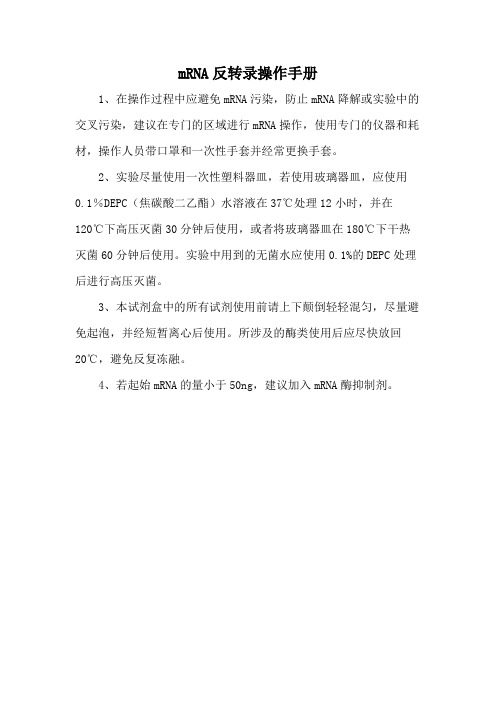
mRNA反转录操作手册
1、在操作过程中应避免mRNA污染,防止mRNA降解或实验中的交叉污染,建议在专门的区域进行mRNA操作,使用专门的仪器和耗材,操作人员带口罩和一次性手套并经常更换手套。
2、实验尽量使用一次性塑料器皿,若使用玻璃器皿,应使用0.1%DEPC(焦碳酸二乙酯)水溶液在37℃处理12小时,并在120℃下高压灭菌30分钟后使用,或者将玻璃器皿在180℃下干热灭菌60分钟后使用。
实验中用到的无菌水应使用0.1%的DEPC处理后进行高压灭菌。
3、本试剂盒中的所有试剂使用前请上下颠倒轻轻混匀,尽量避免起泡,并经短暂离心后使用。
所涉及的酶类使用后应尽快放回20℃,避免反复冻融。
4、若起始mRNA的量小于50ng,建议加入mRNA酶抑制剂。
- 1、下载文档前请自行甄别文档内容的完整性,平台不提供额外的编辑、内容补充、找答案等附加服务。
- 2、"仅部分预览"的文档,不可在线预览部分如存在完整性等问题,可反馈申请退款(可完整预览的文档不适用该条件!)。
- 3、如文档侵犯您的权益,请联系客服反馈,我们会尽快为您处理(人工客服工作时间:9:00-18:30)。
J OURNAL OF V IROLOGY,Dec.1995,p.7851–7856Vol.69,No.12 0022-538X/95/$04.00ϩ0Copyright᭧1995,American Society for MicrobiologyRegulation of Coronavirus mRNA TranscriptionGUIDO VAN MARLE,WILLEM LUYTJES,ROBBERT G.VAN DER MOST,TAHAR VAN DER STRAATEN,AND WILLY J.M.SPAAN*Department of Virology,Institute of Medical Microbiology,Faculty of Medicine,Leiden University,2300AH Leiden,The NetherlandsReceived30June1995/Accepted19September1995Coronaviruses synthesize a nested set of six to eight subgenomic(sg)mRNAs in infected cells.These mRNAsare produced in different,but constant,molar ratios.It is unclear which factors control the different levels ofsg mRNAs.To determine whether the intergenic sequence(IS)involved in sg mRNA synthesis could affect thetranscription efficiencies of other ISs and in this way regulate transcription levels,we inserted multiple ISs atdifferent positions into a mouse hepatitis virus defective interfering RNA.Quantitation of the sg RNAsproduced by identical ISs in different sequence contexts led to the following conclusions:(i)transcriptionefficiency depends on the location of the IS in the defective interfering virus genome,(ii)downstream ISs havea negative effect on transcription levels from upstream ISs,and(iii)upstream ISs have little or no effect ondownstream ISs.The observation that a downstream IS downregulates the amounts of sg RNA produced by anupstream IS explains why the smaller sg RNAs are,in general,produced in larger quantities than the largersg RNAs.Our data are consistent with coronavirus transcription models in which ISs attenuate transcription.In these models,larger sg RNAs are synthesized in smaller amounts because they encounter more attenuatingISs during their synthesis.During infection,coronaviruses produce a3Ј-coterminal nested set of subgenomic(sg)mRNAs which are transcribed independently(6,33).These sg mRNAs contain a common leader sequence derived from the5Јend of the genome.For mouse hepatitis virus(MHV),this leader sequence is72nucle-otides(nt)in length(28).The joining of the5Јleader RNA to the mRNA is believed to be a discontinuous transcription process(11,25).On the genome,the transcription units for the mRNAs are preceded by short,conserved sequence elements, referred to as intergenic sequences(ISs)(30).For MHV,every IS contains the sequence5ЈAAUCUAAAC3Јor a closely related sequence(1,9,23).These IS elements are thought to function as promoters for sg mRNA synthesis(16,30).To explain the synthesis of leader-containing sg mRNAs,it has been proposed that short leader RNA species act as prim-ers(10,26).According to this so-called leader-primed tran-scription model,short leader RNAs are transcribed from the3Јend of the antigenome,translocated to an IS on the negative-strand template,and then elongated to form leader-containing sg RNAs.In the original leader-primed transcription model, the template for transcription was a single,genome-length minus strand(12).However,the discovery of sg-size negative strands(5,20,24)has created questions on the nature of the template(s)for transcription.Recently,it has been demon-strated that the sg negative strands are transcriptionally active (20,21).These results have led to several new transcription models.Sethna et al.(22)speculated thatfirst sg mRNAs are pro-duced in the classic leader-primed fashion.These sg mRNAs are then used as templates for the synthesis of sg negative strands.Subsequently,the sg mRNAs are amplified from their negative-strand counterparts as replicons.However,to date,all attempts to obtain direct evidence for mRNA replication have failed.Transfecting synthetic mRNAs into coronavirus-in-fected cells did not result in replication of the sg RNA(2,14,16),but it could well be that transfected sg RNAs are not suitable templates for replication.An alternative model has been proposed by Sawicki and Sawicki(20).They suggested thatfirst a nested set of sg neg-ative strands is synthesized and that these RNAs serve as templates for the synthesis of the corresponding mRNA and not vice versa.In principle,the discontinuous transcription step,in which the leader sequence is attached to the mRNA body sequence,could still take place,via leader priming on the sg negative strands or during negative-strand RNA synthesis.A major question that remains to be answered is how the levels of sg mRNA are regulated.It has previously been pos-tulated that the extent of base pairing between the leader and the IS on the negative strand would control transcription levels (24).However,we recently demonstrated that the extent of base pairing does not control mRNA abundance,nor is it regulated by the sequence of the IS itself(30). Coronavirus mRNAs are,in general,synthesized in amounts that are inversely related to their size.It is possible that the size of the mRNA determines its abundance.However,it has been proposed that the generation of this apparent gradient of sg mRNA arises because larger RNA molecules are more prone to premature transcription termination and therefore pro-duced in lesser quantities than smaller RNAs(9).This atten-uation of transcription could occur during either of the two phases of transcription.RNA transcription initiation events on a downstream IS on the negative-strand template may cause the polymerase to pause,followed by premature termination of transcription,and so attenuate positive-strand synthesis(9). Alternatively,attenuation could occur during negative-strand synthesis(20)because of differential premature termination on the ISs.This latter idea is consistent with the model proposed by Sawicki and Sawicki.In this case,larger negative strands are produced in smaller quantities than the smaller strands be-cause they have to be synthesized across more transcription-attenuating ISs on the positive-strand template.In this view, the levels of sg RNAs would be determined primarily by the amounts of sg negative strands.To test the hypothesis that transcription attenuation is an*Corresponding author.Phone:(31)-71-261652.Fax:(31)-71-263645.Electronic mail address:azruviro@rulcri.LeidenUniv.nl.7851important factor controlling the levels of sg mRNAs,we in-serted multiple wild-type(wt)and mutant(mut)mRNA3ISs at different positions into an MHV defective interfering(DI) RNA vector.For this purpose,we have used a full-length cDNA clone of a naturally occurring DI RNA,pMIDI-C(29). Quantitation of the levels of sg DI RNAs produced by the different DI constructs led us to conclude that a functional downstream IS attenuates transcription from an upstream IS and not vice versa.Moreover,we found that transcription efficiency is also determined by the position of the promoter on the DI genome.The implications of ourfindings for the mech-anism of transcription of coronaviruses are discussed.MATERIALS AND METHODSCells and viruses.Mouse L cells and17Cl1cells were grown in Dulbecco’s modified Eagle’s medium containing10%fetal calf serum.17Cl1cells were used for the production of high-titered virus stocks of MHV-A59(19).All transfection and passaging experiments were performed with mouse L cells(27). Recombinant DNA techniques.Standard recombinant DNA procedures were used(18).Restriction enzymes,T4DNA ligase,and T4polynucleotide kinase were obtained from Gibco BRL.The T7sequencing kit of Pharmacia and [␣-33P]dATP of NEN-Dupont were used for DNA sequence analysis.All enzyme incubations and biochemical reactions were performed according to the instruc-tions of the manufacturers.Construction of the multiple promoter-containing DI constructs.Oligonucle-otide cassettes containing a mixture of wt and mut mRNA3ISs were obtained by mixing complementary oligonucleotides(Table1)in equimolar amounts in a buffer containing50mM NaCl,8mM MgCl2,1mM dithiothreitol,and10mM Tris-HCl(pH7.5).The oligonucleotides were annealed by slowly decreasing the temperature from95to4ЊC.The resulting double-stranded cassettes contained either Mlu I(cassette I)or Eco RI(cassette II)sticky ends.To prevent the formation of concatamers,a1,000-to2,000-fold molar excess of nonphospho-rylated double-stranded oligonucleotides was used during ligation with phos-phorylated vector DNA at16ЊC.Cassettes I and II eliminated either the Mlu I (cassette I)or Eco RI(cassette II)site upon insertion.To select for plasmids containing oligonucleotide cassette insertions,the ligation mixtures were di-gested with either Mlu I or Eco RI prior to transformation.Since cassettes I and II contain mutations,the desired inserts were selected by sequencing with oli-gonucleotides068and C111(Table1).To obtain DI constructs containing combinations of wt and mut mRNA3ISs, oligocassette I,containing a mixture of wt and mut ISs,was inserted in the Mlu I site at position4435of pDIRA/wt and pDIRA1(30).pDIRA/wt and pDIRA1 are pMIDSal derivatives containing a wt and mut mRNA3promoter in the Sal I site at position5196(Fig.1;note that positions in thefigure and in the text refer to pMIDSal).The resulting constructs were used to insert a third mRNA3IS(wt and mut)at the Eco RI site at position4835.First,the Pst I fragment(positions 1145to2508),containing an additional Eco RI site,was removed.Oligocassette II was inserted into the unique Eco RI site of the resulting plasmid.After inser-tion of the oligonucleotide cassette,the Pst I fragment was inserted,resulting in DI constructs containing all possible combinations of three functional and non-functional mRNA3ISs(Fig.1).In vitro transcription and transfection.Plasmid DNA was linearized by using restriction endonuclease Nhe I.In vitro transcripts were generated with T7RNA polymerase and transfected into mouse L cells with lipofectin(Bethesda Re-search Laboratories).In vitro transcription and RNA transfection were per-formed as described previously(29).MHV-A59was used as a helper virus in all transfections.Isolation and analysis of viral RNAs.Intracellular RNAs were isolated as described by Spaan et al.(27).RNAs were separated on1%agarose gels con-taining2.2M formaldehyde and MOPS buffer(10mM MOPS[morpholinepro-panesulfonic acid{sodium salt}][pH7],5mM sodium acetate,1mM EDTA).Subsequently,the RNAs were transferred to Hybond Nϩmembranes(Amer-sham)by electroblotting in MOPS buffer and then were hybridized with100ng of5Ј-end-labelled oligonucleotide C015(Table1)(17).Oligonucleotides were labelled with[␥-32P]ATP(NEN-Dupont)and T4polynucleotide kinase.Quan-titation of the radioactive blots was performed with a Betascope(Betagene). Statistics,including meanϮstandard deviation and F and Student t tests,were performed by using Microsoft Excel5.0(Microsoft Corporation). Oligonucleotides.An Applied Biosystems391PCR MATE oligonucleotide synthesizer was used for the synthesis of oligonucleotides.RESULTSConstruction of DI RNAs with multiple ISs.To investigate how ISs influence each other,the IS element of mRNA3was introduced at three different positions in the genome of the synthetic DI RNA MIDSal(30)(Fig.1).This approach also allowed us to study the effect of the location of an IS on its transcription efficiency.The plasmid from which MIDSal RNA is transcribed,pMIDSal,is a derivative of pMIDI-C in which a Sal I site was introduced directly downstream of the DI open reading frame(ORF)(30).pMIDI-C is a full-length cDNA clone of a naturally occurring MHV-A59DI RNA(31).We inserted wt mRNA3ISs(5ЈUAAUCUAAAC3Ј);as a control, we inserted mut mRNA3ISs(5ЈUAAUGUAAAC3Ј),which are transcriptionally inactive because of the C-to-G substitu-tion(30).The ISs were inserted as double-strand cassettes in the Mlu I,Eco RI,and Sal I sites of pMIDSal.These positions will be referred to as A,B,and C,respectively,in the DI RNA (Fig.1).Since the ORF which is present in the MHV-A59DI RNA is required for efficient propagation of the DI(4,32),the IS insertions at positions A and B were made in frame.We constructed a panel of recombinant DI RNAs contain-ing all possible combinations of three wt and mut mRNA3ISs (Fig.1).The DI constructs are named after the positions of the ISs in the DI genome.The wt ISs are indicated by capital letters,and mut ISs are indicated by lowercase letters.For instance,DI construct Abc contains a functional wt mRNA3IS at position A and mutant mRNA3ISs at positions B and C of the DI genome.The resulting DI constructs were expected to produce one,two,three,or no sg DI RNAs.The sg DI RNAs produced by the ISs at positions A,B,and C should have sizes of1.2,0.75,and0.4kb,respectively.These sg RNAs will be referred to hereafter as sg RNAs A,B,and C,and their corresponding ISs will be referred to hereafter as ISs A,B,and C.Throughout this study,transcription efficiency is defined as the amount of sg DI RNA relative to the genomic DI RNA (16,30),as determined by beta-scanning of Northern(RNA) blots.Transcription efficiencies of DI-borne ISs A,B,and C.In vitro-transcribed RNAs of the DI constructs were transfected into MHV-A59-infected L cells.After16h,the progeny virus (P0)was harvested and used to inoculate fresh L cells.The resulting P1virus stock was used to inoculate fresh L cells, from which RNA was isolated,7to8h postinfection(P2 RNA).The P2RNA preparations were separated on formal-TABLE1.Sequences and characteristics of oligonucleotidesOligonucleotide Sequence(5Ј33Ј)Polarity a Position(nt)in MIDSal Purpose C066CGCGCATAAT(C/G)TAAACATϩCassette I C067CGCGATGTTTA(G/C)ATTATGϪCassette I C082AATTGTAAT(C/G)TAAACϩCassette II C081AATTGTTTA(G/C)ATTACϪCassette II 068TTTTATGGATTTAGATGATGϩ4410–4430Sequence analysis C111GGCTCCAACAGTTGGTGCCTTCϩ4784–4805Sequence analysis C015ATTCATTCTCTGTCGAϪ5197–5212HybridizationaϪ,antisense;ϩ,sense.7852VAN MARLE ET AL.J.V IROL.dehyde-agarose gels,and viral RNAs were analyzed by North-ern blotting.We specifically chose to use Northern blots in-stead of dried gels for hybridization,since a fraction of the smaller subgenomic DI RNAs might be lost during the drying process,resulting in an underrepresentation of these RNA molecules (data not shown).For probing the Northern blots,we used radiolabelled oligonucleotide C015(Table 1).This probe specifically binds to the DI constructs and their sg DI RNAs.It does not detect DI RNAs that have lost the inserted ISs by recombination with the viral genome (31).However,the probe has some residual affinity for MHV RNAs 1to 7and cross-hybridizes with the 18S and 28S rRNAs which are visible as extra bands on the blots.The Northern blot analysis of the intracellular RNAs showed that all DIs replicated efficiently and produced sg DI RNAs of the expected lengths (Fig.2).The transcription effi-ciencies of the ISs at positions A,B,and C in the several DI constructs were determined in seven independent experiments (Table 2).Our data clearly demonstrate that the constructs Abc,aBc,and abC produced different amounts of sg DI RNA.The IS at position B in construct aBc gave rise to the largest amount of sg RNA,approximately twice as much as the IS at position C in construct abC.The IS at position A in construct Abc pro-duced the smallest amounts of sg RNA.Accordingly,in con-struct ABC,sg RNA B was the most abundant and sg RNA A was the least abundant.Also in constructs ABc,AbC,and aBC,the 1.2-kb sg RNA A was the least abundant and the 0.75-kb sg RNA B was the most abundant sg DI RNA species.Thus,insertion of multiple functional ISs into the DI constructs yielded the same pattern of sg RNA abundances as the DIs containing a single functional IS.These results strongly suggest that the position of an IS on the genome can have a major effect on the amounts of sg RNA that are produced.It is alsoFIG.1.Schematic representation of DI constructs.The pMIDSal construct is outlined at the top.The boxes indicate the regions (polymerase ORF 1A [1A],polymerase ORF 1B [1B],and nucleocapsid gene [N])derived from the MHV-A59genome which constitute the DI.The small box at the 5Јend depicts the leader.The restriction enzyme recognition sites in which ISs were inserted are indicated.The numbers represent their distances (in nucleotides)from the start of the synthetic RNA.The three insertion sites are referred to as positions A,B,and C in the DI.The black bars indicate the relative sizes of the sg RNAs produced from the ISs at positions A,B,and C on the DI.The complete panel of DI constructs,containing each possible combination of three mutant and wt ISs,is shown at the bottom of thefigure.FIG.2.L cells were infected with MHV-A59and transfected with the synthetic DI RNAs,and progeny virus was passaged twice.P2RNA was isolated and separated on formaldehyde-agarose gels,blotted onto nylon membranes,and hybridized with 5Ј-end-labelled oligonucleotide C015.The positions of the DI RNAs and sg DI RNAs (referred to as A,B,and C)are indicated by arrows.V OL .69,1995REGULATION OF CORONAVIRUS mRNA TRANSCRIPTION 7853clear from our data that the smallest sg RNA does not neces-sarily have to be the most abundant.In other words,the abun-dance of an sg RNA does not seem to be a function of its size. We also observed that the presence of one or more functional ISs did not have a major impact on the accumulation of the parental genomic DI RNA.In all experiments,the DIs accu-mulated to similar levels whether they were producing sg RNA or not(data not shown)(Fig.2).Transcription efficiencies are influenced by adjacent ISs.A comparison of the transcription efficiency of a given IS in the presence or absence of other functional ISs(Table2)sug-gested that the presence of additional functional ISs was in-fluencing transcription efficiency.To investigate this in more detail,we performed a statistical analysis on the data shown in Table2by using a cutoff value of Pϭ0.05.For IS A,an F test showed significant differences(Pϭ0.04) in the amounts of sg RNA produced in the presence or absence of functional ISs at positions B and C.In a subsequent Student t test,we compared construct Abc with the other constructs. This test showed that the amounts of sg RNA A decreased significantly in the presence of a functional IS at position B (construct ABc,Pϭ0.006),C(construct AbC,Pϭ0.04),or B and C(construct ABC,PϽ0.001).Similarly,for the IS at position B,the F test showed significant differences(Pϭ0.038) in the amounts of sg RNA produced in the presence or absence of other functional ISs.The Student t test showed that the transcription efficiency of IS B in construct aBc differed signif-icantly from the transcription efficiency of this IS in the pres-ence of functional ISs at position C(construct aBC,Pϭ0.026) or A and C(construct ABC,Pϭ0.048).However,in the case of construct ABc,the functional IS at position A,upstream of B,had no significant effect(Pϭ0.501)on the amounts of sg RNA B.Thus,it appears that functional downstream ISs affect the transcription efficiency of upstream ISs but not vice versa. In accordance with this notion,the F test showed no significant difference(Pϭ0.7)in the levels of sg RNA produced by IS C in the presence or absence of functional upstream ISs,i.e.,at positions A and B.In conclusion,our data indicate that the transcriptional ef-ficiency of an IS is downregulated by functional downstream ISs,while functional upstream ISs do not influence down-stream ISs.We observed this inhibitory effect over distances ranging from361to400(in constructs ABC,ABc,and aBC)to 761(in construct AbC)nt.DISCUSSIONUntil now,most studies on coronavirus transcription using DI RNAs have focused on transcription from a single IS.Coronaviruses produce more than one mRNA,and it is pos-sible that the transcriptional activities of the ISs influence each other and that this plays a role in controlling coronavirus sg RNA levels.To address this issue,we inserted wt and mut mRNA3ISs at multiple positions(denoted A,B,and C)into our DI RNA vector.The position of an IS affects transcriptional efficiency.Anal-ysis of the DI constructs containing a single functional IS revealed a clear difference in the amounts of sg RNA produced by the mRNA3ISs at positions A,B,and C of the DI genome. The IS at position B in construct aBc produced the largest amounts of sg RNA,while the IS at position A in construct Abc produced the smallest amounts.The pattern of sg RNA accumulation in the DIs containing multiple functional ISs was similar to that of the constructs containing one functional IS, i.e.,the product of the IS B was the most abundant and that of the IS A was the least abundant.These data suggest that the position of the IS on the DI genome strongly affects the amounts of sg RNA it produces.This observation is in accor-dance with earlier data showing that the amounts of sg RNA that are generated by an IS can depend on theflanking se-quences,which are not specific(8,15).The influence of the flanking sequences could stem from the overall RNA second-ary structure.Recently,Zhang and Lai found a correlation between the amounts of sg RNA produced by wt and mut MHV mRNA2ISs and the affinities of cellular proteins for these ISs(34).From our study,it is clear that the differences in transcription efficiencies cannot be explained by differences in the affinities of these proteins for the IS because we used the same mRNA3IS at positions A,B,and C.What we cannot exclude is that the observed differences in sg RNA abundances are caused by differences in RNA stabilities.This is a possibil-ity that we are currently testing.For MHV,there is an inverse correlation between size and abundance of sg mRNA.In MHV-infected cells,the smallest RNA is the most abundant.This correlation is not observed for the coronaviruses transmissible gastroenteritis virus(TGEV) (22)and feline infectious peritonitis virus(FIPV)(3).In both these viruses,the smallest mRNA accumulates to lower levels than that of the next larger mRNA.Interestingly,the pattern of sg RNA accumulation observed for construct ABC bears resemblance to that of TGEV and FIPV,i.e.,the smallest of the three sg RNAs produced by construct ABC was not the most abundant.Since a direct correlation between size and sg RNA abundance was not seen for any of our constructs,we conclude that the size of the RNA does not exclusively deter-mine its accumulation.We observed that the production of sg RNAs from the DI construct did not have a major effect on its accumulation.The DI RNAs producing one or more sg DI RNAs accumulated to levels similar to that of the DI RNA producing no sg RNAs. This would suggest that transcription and replication do not influence each other.These data are in conflict with the ob-servations of Jeong and Makino(7)and Lin et al.(13).They reported that sg DI RNA synthesis from MHV-JHM-derived DI constructs inhibited the replication of the DI genome. What causes these different observations is unclear. Transcription efficiency is influenced by adjacent ISs.The aim of our study was to investigate factors that rule coronavirus mRNA synthesis.One of the factors we investigated was how the transcription efficiency of a given IS is influenced in cis by the presence of other ISs.Determining the transcription effi-ciencies of the functional ISs in our DI constructs showed a significant inhibition by the presence of functional ISs down-stream.However,there was no significant effect of functional ISs on downstream ISs.We observed that functional down-TABLE2.Transfection efficienciesConstructTranscription efficiency aIS A IS B IS CAbc27Ϯ13––aBc–227Ϯ94–abC––91Ϯ22ABc8Ϯ7254Ϯ36–AbC13Ϯ10–103Ϯ33aBC–164Ϯ22109Ϯ58ABC7Ϯ5133Ϯ18107Ϯ42abc–––a The ratio(and standard deviation)between the amount of sg DI RNA andgenomic DI RNA,determined by beta-scanning of Northern blots in sevenindependent experiments.–,no sg RNA detected.7854VAN MARLE ET AL.J.V IROL.stream ISs could have inhibitory effects over distances of361to 400nt(constructs ABC,ABc,and aBC)and761nt(construct AbC).In an earlier study of MHV transcription,Joo and Makino (8)have investigated the transcription efficiencies of two adja-cent ISs.The distances between these two ISs varied from23to 124nt.They concluded that there was a dramatic inhibition of the transcription efficiency of an upstream IS by the down-stream IS when the ISs were23nt apart.The extent of inhi-bition decreased as the distance between the ISs increased.ISs that were124nt apart produced almost equal amounts of sg RNA.Joo and Makino(8)explained this strong inhibition of upstream ISs by downstream ISs by steric hindrance.Binding of transcription factors or the transcription complex on the downstream IS could limit the accessibility of the upstream IS if they are close together(i.e.,23nt).In our study,the dis-tances between the ISs ranged from361to761nt,therefore it is unlikely that the inhibition of an upstream IS by a down-stream IS is caused by steric hindrance.Neither can this inhib-itory effect be caused by competition for the polymerase,since this would result in inhibition of transcription of all ISs,which is not what we observed.In fact,the observation that down-stream ISs attenuate upstream ISs and not vice versa is con-sistent with two models for coronavirus transcription(9,20) (Fig.3).Konings et al.(9)proposed,on the basis of the available data at that time,that attenuation occurring during positive-strand synthesis determines mRNA levels.Transcription starts on an IS on the negative-strand genomic template by leader priming.When the polymerase encounters a functional down-stream IS during positive-strand synthesis,it pauses because of initiation of transcription on the downstream IS.This may result in termination of transcription by the polymerase.The more the polymerase is forced to pause,the more chance it has to terminate and consequently,the less RNA it will make. Thus,the initiation events on downstream ISs are the attenu-ating factors for transcription.In a more recent model pro-posed by Sawicki and Sawicki(20),attenuation of transcription occurs during negative-strand synthesis.In this model,the ISs on the positive-strand template function as transcription at-tenuators or even differential terminators for negative-strand synthesis.This would result in the formation of a nested set of sg negative strands.A portion of the polymerases detaches from the positive-strand template when it reaches an IS se-quence to form an sg negative strand.Thus,the synthesis of a larger sg negative strand,i.e.,the product of the upstream IS, is attenuated by the presence of a downstream IS because only a percentage of the polymerase complexes reach the upstream IS.The anti-leader on the sg minus strand is transcribed either after a template jump to the5Јend of the genome or after hybridization of leader fragments to the nascent minus-strandIS.In either model it is unclear what physically causes the poly-merase to pause during positive-strand synthesis or to termi-nate during minus-strand synthesis.Proteins bound to the IS on the negative or positive strand may play a role.These proteins could be of viral origin or host proteins.The recent finding that host proteins bind to the wt ISs and not to mutant ISs(34)is consistent with this hypothesis.However,the nature and function of these proteins remain to be determined. Although our data indicate that attenuation of transcription by downstream ISs does occur,we cannot discriminate be-tween attenuation during negative-or positive-strand synthe-sis.A recent study on coronavirus transcription done by Schaad and Baric(21)strongly suggests that sg negative strands are functional and play an important role in transcrip-tion.This observation would favor attenuation according to the transcription model proposed by Sawicki and Sawicki(20).In conclusion,we have demonstrated that two different prin-ciples can govern the synthesis of sg RNAs in coronaviruses. The DI constructs containing multiple ISs demonstrated that attenuation of the transcription levels of sg RNAs by down-stream ISs occurs,which would lead to a gradient of sg RNAs in which the smaller sg RNAs are synthesized at higher levels. From the data obtained with the DI constructs containing a single functional IS,we show that its position on the genome can determine the level of sg RNA produced,in a nongradient fashion.Both principles apparently play a role in coronavirus transcription simultaneously.This explains the sg RNA pat-terns for constructs ABC and aBC and also those of corona-viruses TGEV and FIPV.The factors involved in attenuation FIG.3.The models for transcription attenuation as proposed by Konings et al.(9)(I)and Sawicki and Sawicki(20)(II).The ISs(A,B,and C)on the positive-and negative-strand template are indicated with boxes.Plus-and minus-strand RNAs are represented by solid and dotted lines,respectively,and by plus and minus signs within parentheses.The polymerase complex is depicted as a black circle;the associated arrows symbolize initiation events.During plus-strand synthesis(I),transcription pauses on a downstream IS because of initiation events on that IS.Subsequently,transcription is either resumed,yielding mRNA A or B,or terminates prematurely.The amount of a particular sg RNA synthe-sized depends on the frequency of premature termination which is a function of the duration of the pausing and on the number of ISs that have to be passed.The smallest mRNA should be produced more efficiently because it is not hampered in its synthesis by downstream ISs.During minus-strand synthesis(II),a portion of the polymerases detaches from the positive-strand template after reaching an IS and releases sg minus strands while the remaining polymerases continue rger sg minus strands will be produced less efficiently than smaller ones because they have to be synthesized across more ISs where ever-smaller portions of the polymerases remain.The amount of sg minus strands produced will determine the levels of sg mRNAs.V OL.69,1995REGULATION OF CORONAVIRUS mRNA TRANSCRIPTION7855。
